Following in my father’s footsteps: A journey into the Spanish Civil War
In the summer of 2012 I set out on the trip of my lifetime: To discover the father I never knew. I simply felt I had to go to Spain to see many of the places and events he described in the journal he wrote as an ambulance driver in Spanish Civil War from 1937 until 1938.
Joining me on the trip was an eclectic mix of people with an interest in the Spanish Civil War: an expatriate British historian; a high school Spanish teacher from North Carolina; and a American graduate student living in England. Together we traveled over a thousand miles in 10 days, traversing cities, villages and former battlefields of the Spanish Civil War. During our trip we met with historians and survivors of the war. As we collected their stories, and created our own, we recorded the experience to turn it into a documentary film. (To learn about our crowd-funding campaign and see a trailer of the film, click here.)
My father, James Isadore Neugass, was a ghost to me for most of my life. He died in 1949 of a heart attack in Greenwich Village when he was only forty-four. I was eighteen months old and my brother Paul was seven. A year later, my mother Myra relocated our family from New York City to Los Angeles to start over again. As the years passed, my mother’s memories of her husband faded but she always said that he was a good father and loved us very much. She said he had been born into a wealthy Jewish family in New Orleans but left at a young age to become a writer in New York City. He loved to write poetry.
As a teenager, I remember looking in two old cardboard boxes of family pictures. One stood out from the others: an old black and white picture with six uniformed men and two nurses. It looked like they were going to war in a far-off place. My mother said that the tallest man second from the right with the mustache was my father and that he going to Spain to drive an ambulance in the Spanish Civil War. I had no idea what the war had been about or why he went there. In another box I found an old red patch that he probably wore on his uniform and an old, cracked and weathered notebook. Its yellowed paper was covered in handwriting, but it was hard to read and I never asked my mother about it.
I gained a clearer understanding of my father’s life of on a visit to my Aunt Bessie in New Orleans when I was in my forties. I had had little contact with her growing up but I wanted to ask questions about my father. In a frank way, she said that he was an embarrassment to the family because he was a member of the American Communist Party and a union organizer who had gone off to the Civil War is Spain in 1937. I realized this must have been why the family had shunned my mother and brother, and me throughout our lives. My father had been the black sheep.
Then a series of events occurred that would change my life forever. I would discover who my father was, why he went to Spain, and what he experienced there. I also discovered what he was made of.
In 2000, a professor of Spanish language and literature from the University of Illinois contacted my mother requesting permission to use some of our father’s poetry in a book he was writing. In a conversation with my brother Paul, he asked if we knew about my father’s unpublished manuscript “War is Beautiful: Journal of an American Ambulance Driver in Spain,” which had been found in a rare bookstore in Vermont having spent more than 60 years in an old attic. It was the first we heard of it.
Reading the manuscript, I realized a door into the past had opened. At last, I had the chance to know my father. Providence had smiled on me, and I smiled back. There have been many times I have looked up towards the sky wishing my father could see how proud I was of him and the contribution he made in Spain. War is Beautiful: An American Ambulance driver in the Spanish Civil War was published by the New Press in 2008.
After a few weeks of meetings over email and Skype, the eclectic group behind the documentary met in Barcelona and began our journey in July of 2012.
The crew and the journey
Joining me on my trip were Alan Warren, Aelwen Wetherby, and Dorothy Eubanks:
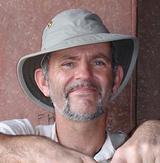
British expatriate Alan Warren from Barcelona, has been conducting tours for those interested in the Spanish War for many years.
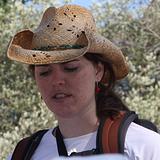
Aelwen Wetherby, a doctoral student in History at the University of Oxford and director and producer of our documentary film.
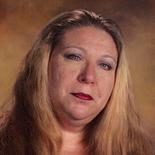
Dorothy Eubanks, a Spanish teacher in North Carolina, completed her master’s thesis on the medical advances of the medical volunteers in Spain.
After a long flight from Charlotte NC, I arrived in the Barcelona airport to be greeted with hugs by my two smiling American comrades. We set out on a hot journey by subway to Alan’s flat where, after a meal of mushroom soup, we crashed for the night. By noon the next day Alan arrived with a small hatchback car in which we loaded all of our baggage. It wasn’t exactly spacious, but it would carry us over 1,000 miles of Spanish highways and back roads.
Our first stop was Madrid, where we saw the film The Mexican Suitcase, ate tapas and drank red wine. Next we went on a commemorative walk along with two hundred participants through the former battlefield of Brunete and visited a war museum with historic guns, shells, grenades, bullets, gas masks, rifles, and old newspapers showing Hitler and Mussolini standing together with Franco. Then we set out over the rough but beautiful Spanish countryside to visit the places my father mentioned in his book. It is impossible to cover them all, so I will share a few of my most memorable places with you.
It has taken me a number of months to realize the power of my voyage in Spain. I feel proud of my father’s legacy and the wonderful opportunity to know him.
Jim Neugass lives in Asheville, North Carolina and has worked as Registered Nurse in Hospice and as a Manufacturers Representative marketing medical devices to Hospitals. He is currently semi-retired as a Licensed Massage Therapist. Jim can be contacted by emailing him at: jimneugass@yahoo.com.
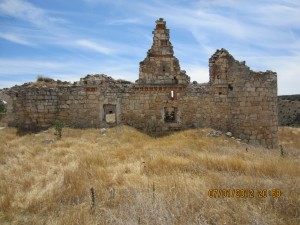
On December 5th, 1937 James Neugass arrived in Spain and the Village of Saelices. There he saw these old Moorish ruins called El Castillejo (Pictured). Just down the road he arrived at the American Hospital in Villa Paz where he would wait in frustration to go into action.

On December 11th in the village of Ambite near “The Old Watermill” he first encountered a convoy of the 15th Brigade of the Lincolns gathering to prepare for war. They were carrying water, gas, oil, guns and troops.
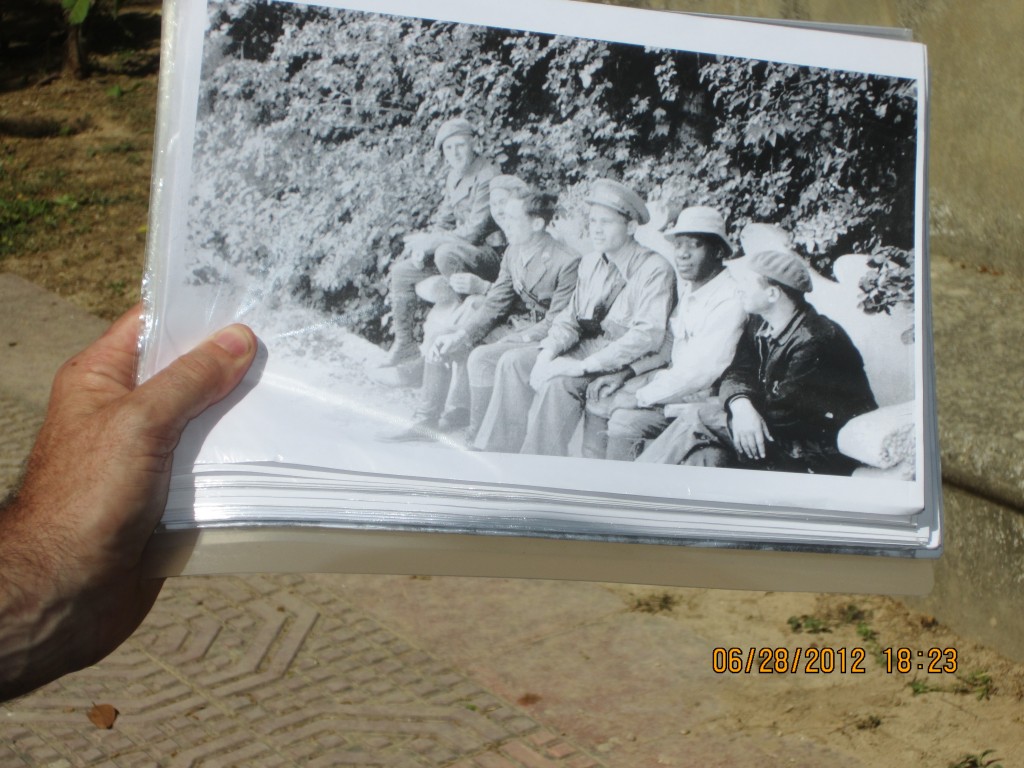
On the same grounds in the same time period, sitting on the concrete bench is the African American, Harry Haywood and Steve Nelson.
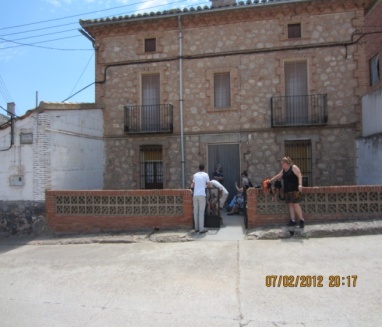
This is the 15th Brigade Hospital in Cuevas Labradas,
In the attic on the 3rd floor we found graffiti on the whitewashed walls of the former hospital ward. One note written in pencil reminded wounded soldiers: “Don’t spit on the floor”. Perhaps it was “Queen Annie, our most important Nurse” in War is Beautiful.

As the Republican Army began their offensive action in the winter of 1938, the terrible battle for Teruel saw my father rushing wounded and dying solders off the battlefield while in great danger. He was under fire, engaged in hand-to-hand combat to save his life, lost in the in snow and blistering cold.

James Neugass accompanying Cuban volunteer Pablo Carbonell, killed in action in the Battle for Teruel, 1937
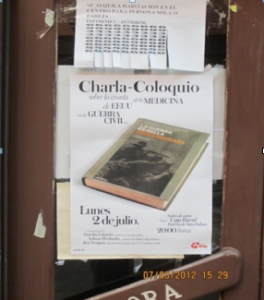
In many cities and villages in Spain, the topic of the Spanish Civil War remains a controversial issue and yet there are people who want to know more about it, especially the young. Teruel was one of those cities. Aelwen and I both made presentations there in a small but packed room with people who wanted to hear the stories about our journey. We were welcomed with open arms.
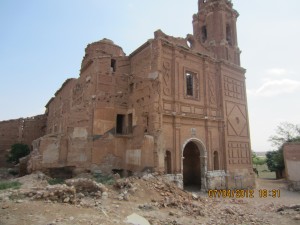
Nearing the end of our trip, we stopped in the war memorial in Belchite. My father wasn’t involved in the battle here, but it was completely destroyed but left by Franco as a reminder. War is horrible….
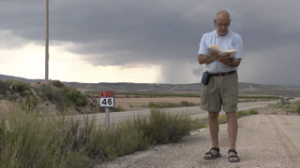
Nearing the end of our journey we stopped at Milepost 46, where I read a passage from War is Beautiful in which my father’s unit is about to be attacked by fascist troops only a thousand meters away. As I read, a strong surge of wind all of a sudden picked up behind me, while thunder and lightning boomed, sounding just like we were being shelled. I wept because I realized that I knew about as much about my father as I would ever know, yet I still would not be able to feel his arms around me.

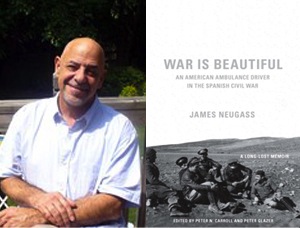
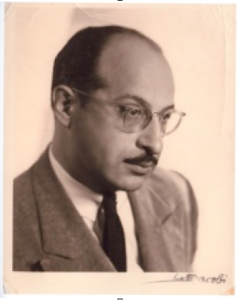
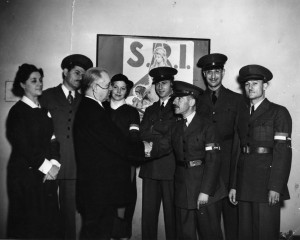












Am so grateful to have been a part of your journey Jim!! Thanks for sharing this.
Yes. It was a lot of fun and I look forward to the release of the film in the near future. I hope it will be a great success and allow readers of the book in both Spanish and English to see just a small fraction of what we and your Father witnessed whilst driving his ambulance “Josephine”.
Beautiful journey and beautiful story. I would love to read some of the poetry and I look forward to seeing the documentary.
Appreciated Jim:
I read “War is Beautiful” one year ago. It was a very catching story and at the same time, it discovered me a part of the history of Spain I didn’t know beause it is still keep hiddden. His moving and sincere descriptions of the day by day routine, helped me to imagine how it was the live of the medical staff of the XV Brigade. As I live in Valencia, I enjoyed following his photographical descriptions of the road from Teruel, how the landscape changed so dramatically from the Spanish North Pole ( Teruel), to the exuberant and warm shore of Levante.His spontaneous reactions and intimate thinks are fatured in a journalistic style that makes the book an easy reading.
Gracias James Neugass. Hasta la vista!
Just to let people know that we successfully raised the crowdfunding necessary to complete the documentary. It should soon be out!
Many thanks to those who helped make this happen.
Alan Warren and the rest of the team!
[…] història, a més, ens acosta al retrobament d’un fill amb son pare a través del seu propi diari, el qual no va eixir a la llum fins gairebé seixanta anys després […]
One of my students just discovered this article!! I was so overwhelmed by the many memories that we made on that trip as well as the history that we relived. Thank you to Jim, Aelwen and Alan for the experience of a lifetime!
Dorothy